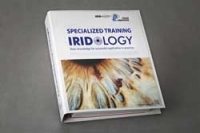Professional Training in Iridology
Content Course 3
Contents of the 3rd Chapter of Learning Results
In the third chapter, the know-how of more complex systematic connections and their representation in the iris are taught, the combination of diverse signs and phenomena as well as the sectorally and regionally spreading (relevant) connections. Besides, a structured proceeding in regard of an iris anamnesis by the help of an iris microscope is shown, how to evaluate the gained information and how this can be used in practical therapy.
The participants learn how to determine the individual constitution of a person and work out a complete summation and combination analysis of all indications and phenomena.
After being instructed in the functioning and operation of the iris microscope, the participants will work out in teams their personal iris analysis with the assistance and supervision of experts. We provide for high quality iris microscopes.
The results of the team work will be presented by the participants and together with the lecturers, the results will be discussed and checked. On the basis of the iris analysis, further diagnostics and therapy possibilities will be proposed.
1. Individual Constitutions
It is not always easy to differentiate and understand the hierarchy of importance in Iris signs. Using actual patient records, and by comparing the individual Constitutions, Dispositions and Diatheses we gain more clarity.
Is this still a Lymphatic Constitution?
Is this Disposition in the foreground?
Is the Diathesis recognizable or even present?
Which combinations don’t ever show up?
The Advanced Course is all about deepening your understanding of and the practical applications of Iridology.
- 1. Individual Constitutions
- Definition of Terminology
- Constitution, Disposition, Diathesis
- Lymphatic Constitution
- Hematogenic Constitution
- Mixed Constitution
- 2. Neurogenic Disposition
- 3. Mesenchyme/ Connective Tissue Disposition
- 4. Glandular Weakness Disposition
- 5. Immunologic Disposition
- 6. Vegetative-spastic Diathesis
- 7. Exudative Diathesis
- 8. Lipaemic Diathesis
- 9. Hyperacidic Diathesis
- 10. Compensation Diathesis
- 11. Allergic Diathesis
- 12. Practical training
- 13. Question and Answer, Discussion Period
2. Combining and Summarizing
Advanced Topography has the goal of putting it all together. In the Introductory Course phenomena and signs are taught. In the Advanced Course we look at combinations of signs and phenomena in individual sectors as well as in overlapping regions. With many examples from the practice we are able to summarize and find a deeper practical understanding.
- 1. Topographical Overview (Including circular zones)
- 2. Stomach-Intestine Zone
- 3. Fascial Zone
- 4. Head-Brain Region
- 5. Thoracal Region
- 6. Region of Liver - Gall-Bladder - Pancreas - Spleen
- 7. Urogenital Region
- 8. Urorosein Pigments
- 9. Gastrin Pigments
- 10. Orange-colored Pigments
- 11. Liver-related Pigments
- 12. Practical Training
- 13. Discussion and Questions
3. Practical Training
Contents see practial training.





